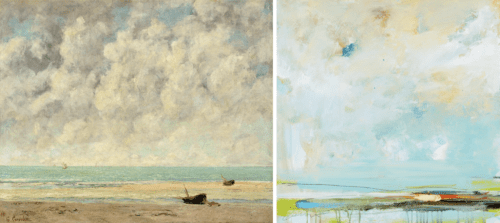Have you ever looked at a contemporary piece of art and thought it looked a little familiar? Chances are that in some way, that piece shows influence by artists of the past! Art is inherently referential, and it is nearly impossible to create something without referencing other art in same way. There are so many of these references within our collection, too many in fact for one blog post. You can read our earlier installment of this series here!
Noland / Hoffman

In these two pieces, the simplicity of the subject matter lends each artist to take bold risks with their color choices. Noland, an influential color field painter, uses a much more limited color palette. Hoffman’s take on the concentric circle is more complex and colorful, showing a natural progression from earlier examples like Noland’s.
See more of Michael Hoffman’s mesmerizing circles.
Courbet / Abrecht

Made almost two centuries apart, both of these pieces depict a calm, serene sky and seascape. Courbet’s is a bit more traditional, with a subdued color palette that reflects the realism he strived to convey. Abrecht’s is much more modern, with brighter colors and hints of abstraction. While stylistically different, both pieces share a similar composition that emphasizes the sky rather than the sea.
See more stunning works by Eric Abrecht.
Warhol / Alan

Of all the historical art references we’ve covered, this one may be the most straightforward. Warhol’s original Brillo Boxes (three are shown here, but he made many more) sparked discussion on what separates art from commercial products. In his version, Alan has used the same subject manner to create a one-of-a-kind piece. Alan has chosen his own words, as well as the same minuscule figures that are found across much of his work, to accompany the familiar branding.
See more of Craig Alan’s work, including more dynamic examples of his Populus series.
Image Sources: Christie’s, Metropolitan Museum of Art, Philadelphia Museum of Art

